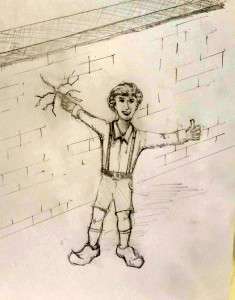CCD Get Over It
 Everyone is tired of the media attention on Colony Collapse Disorder (CCD) By now, everyone knows that CCD is a complex conglomeration of multiple causes and a catchall for everything that plagues the honeybee population. We don’t want to hear, one more time, the opportunistic and misquoted mantra attributed to Einstein that tells us the world will die in four years if scientists and beekeepers can’t solve the multi-faceted death trap called CCD. Hooey! Media has exhausted the identification of CCD, let’s move on to some solutions. CCD get over it
Everyone is tired of the media attention on Colony Collapse Disorder (CCD) By now, everyone knows that CCD is a complex conglomeration of multiple causes and a catchall for everything that plagues the honeybee population. We don’t want to hear, one more time, the opportunistic and misquoted mantra attributed to Einstein that tells us the world will die in four years if scientists and beekeepers can’t solve the multi-faceted death trap called CCD. Hooey! Media has exhausted the identification of CCD, let’s move on to some solutions. CCD get over it
Early in my research, the numbers always seemed important. Surprisingly, 83% of beekeepers in America are hobbyists. The USDA counts beekeepers who own five or more colonies, so out of roughly 120,000 beekeepers, 99,600 manage five colonies or less. If lucky, the hobbyist will extract a mere 300-500 pounds of honey per year, a droplet in a domestic industry that annually produces 145 million pounds and doesn’t come close to meeting demand without 265 million imported pounds.
Some hobbyists attend local bee club meetings but the vast majority learn about keeping bees from another beekeeper, through online communities, books, and ultimately trial and error. It only makes sense that a hobbyist may not be able to spot potential colony dysfunction early enough to intervene before the onset of collapse. Some hobbyists are in and out of beekeeping in a few seasons. The attrition is financial since beekeepers purchase new colonies year after year as keeping a colony alive becomes increasingly more difficult. Most colony die off is simply a failure to perform regular inspections to assess ongoing colony health and know exactly what to look for.
Wisconsin’s Department of Agriculture, Trade and Consumer Protection (DATCP) does not have the manpower to provide sufficient resources to 2,500 Wisconsin beekeepers. Wisconsin state honeybee inspector, Dan Ziehli, travels the entire state, often visiting one beekeeper at a time to encourage and train them to care for and raise healthy bees. It is much like trying to hold back floodwaters by placing a finger over the crack in a dike. The limit is ten fingers. There are more problems than one state inspector can fix. There is also apprehension that exists in asking for help from governing bodies that allocate more budget funds to regulation than education.
Chemical application and regulation is not the direction that will restore honeybee populations. Take, for instance, Oxcylic acid (found in the local hardware store and sold as wood bleach) is used by beekeepers to kill Varroa destructor. The chemical is also a disinfectant to kill bacteria and germs. When the chemical first became available to beekeepers the instruction on dosages and implementation was unclear. USDA responded by requiring a Veterinarian prescription. Most Vets had no more information than the beekeeper. The bottom line is beekeepers will fend for themselves, figuring out best practices with or without cooperative regulation or chemicals.
It seems intuitive that attention should be focused on producing and distributing tougher stock. The north, in particular, needs to reduce imported bee stock. Wisconsin needs its own local breeders that can support local demand. The reasoning seems too simple. Honeybees bred in the north will be acclimated to local climate and local pests. Bee populations will grow healthier if local breeding occurs.
There are many reasons why honeybees are not bred in the north. There is not a lot of money that can be made in northern breeding. The timeline for new spring installations is limited to one cycle, a 40 day window to breed colonies for the spring season. That cycle occurs between May and June and success depends upon the temperature, wind and precipitation cooperating. Too cold, too windy, too much rain and natural open air breeding will not happen.
We’ll save insemination for another discussion.
When northern colonies are sold in late June the nucleus colony is roughly 60 days behind southern bred colonies. The northern colony will need to make up for lost time to build sufficient resources to keep the colony alive over the coming winter. A northern colony will not produce enough honey for itself as well as produce a surplus for the beekeeper to extract in the first season. The honey harvest is not instantaneous. The northern beekeeper must be patient as the new colony overwinters and emerges the following spring to heartily make up for lost time.
The beekeepers management style and timelines need to be completely rewired and overhauled. This task is daunting in the culture of instant gratification. It’s very difficult to teach an old dog new tricks. Likewise, asking beekeepers who traditionally pass the art of beekeeping down from generation to generation through kindhearted advice to suddenly change the expectations is difficult.
This era of new management is emerging slowly, not as top down management but, as promising young beekeepers challenge the status quo, observe, become informed, test theories, and get involved in grassroots efforts to aid and strengthen the industry. The backyard beekeeper shouldn’t wait for the industry experts to form a response to CCD when the majority in the industry is the hobbyist. The solution will more than likely come from a hobbyist. A solution may be found by the young boy who simply stuck his thumb in a hole until the rest of the world noticed.
The CCD mantra certainly encompasses mites, hive beetle, over treatment, mono-culture, pesticide use, and lack of foraging crops but the bulk of the problem is structural with age old expectations based on southern timelines that require adjustment. There must be a paradigm shift, new education, new expectations, and a better infrastructure to sustain bees living in cold climates.
Sweet Mountain Farm began searching for better bees and better beekeeping practices designed specifically for success in northern climates. Altruistic motives gave way to the realization that an Island location doesn’t insure an optimal environment, nor should optimal environments become a prerequisite for healthy bees. Clarity set in after a few years. Keeping bees away from contaminants, pests and disease is never attainable. It is the contaminates, pests and disease that must be used to breed tougher, better stock. The best scenario is to create an ecosystem that puts bees and predators in balance and it is that balance in which bee and pest can effectively coexist. CCD get over it
